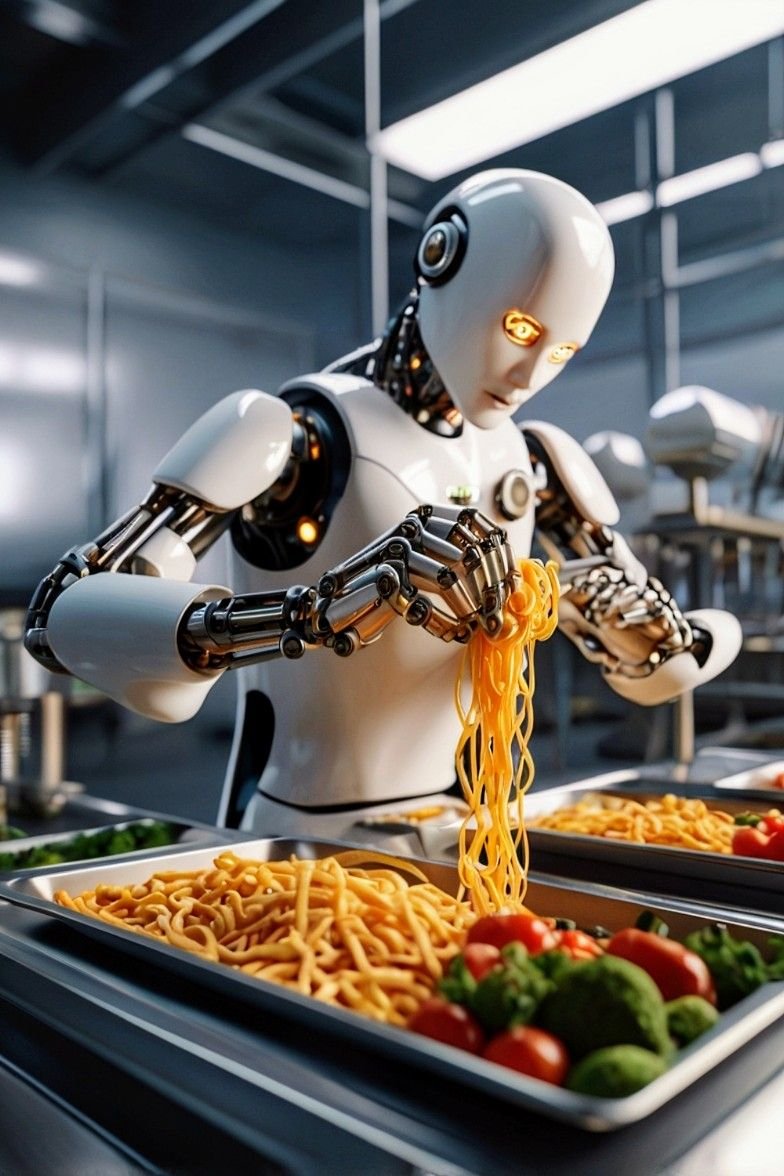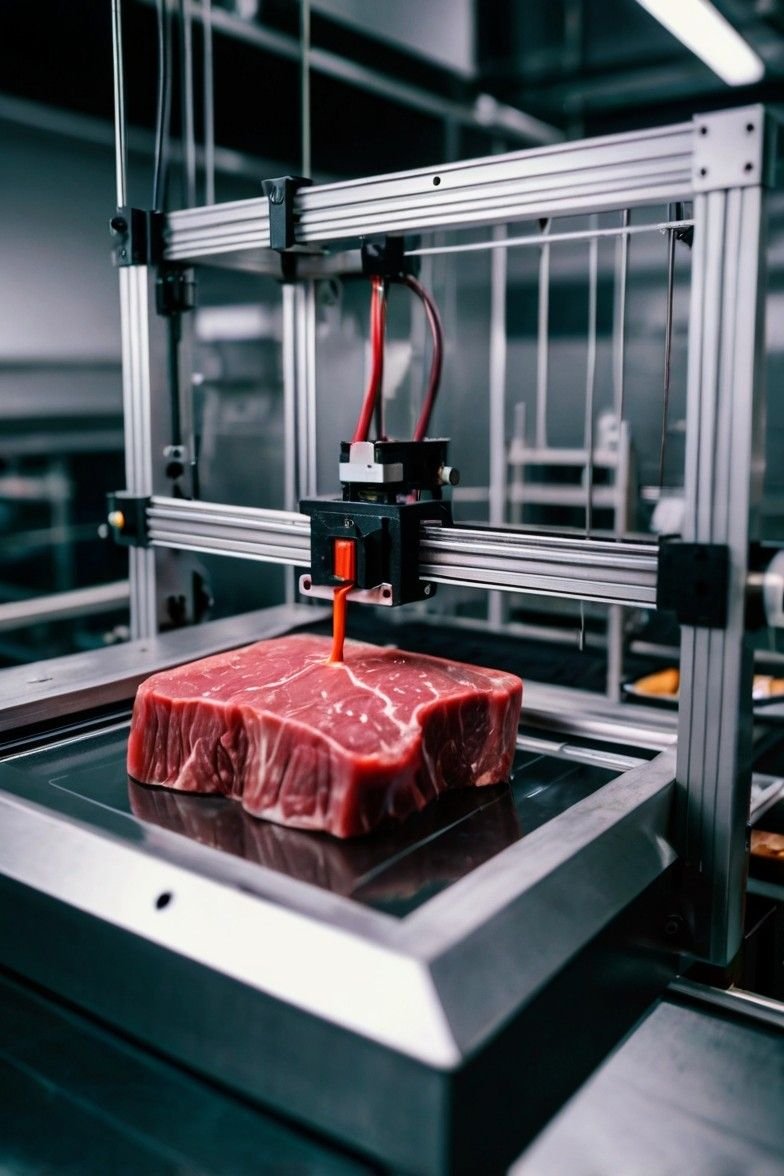AI-Generated Image. Article: What Is Vegan Food Tech & Why Is It Crucial In The War Against Climate Change? by Tech Is The Culture
Vegan Food Tech Is Here & Ready To Fight The War Against Climate Change
Imagine a world where your burger patty is grown in a lab, your steak is 3D-printed from peas, and your cheese oozes without a cow in sight. Welcome to the Matrix of Meals—vegan food tech. This isn’t science fiction; it’s the delicious, climate-saving revolution happening right now in labs, startups, and (soon) your kitchen.
Shall we get into how plant-powered innovations are flipping the script on the food industry and why it’s our best shot at saving the planet without sacrificing bacon-flavored everything?
Vegan Food Tech 101: It’s More Than Just Tofu & Kale
Vegan food tech isn’t just about swapping cows for cashews. It’s a $20 billion arsenal of science, engineering, and culinary wizardry aimed at replicating and improving animal products using plants, fungi, and even thin air. Think:
– Lab-grown meat: Cultivated from animal cells, no slaughter required.
– Precision fermentation: Brewing dairy proteins using microbes (yes, it’s vegan beer for cheese).
– 3D-printed foods: Stacking plant proteins into marbled steaks or shrimp textures.
– AI-driven flavor matching: Algorithms that make pea protein taste like beef fat.
As Joseph Poore, an Oxford researcher, puts it, “Nothing compares to the environmental damage of meat, but vegan tech is here to outsmart it.”
Climate Crisis? Meet The Carbon-Crunching Plate
The Problem (Cows vs. the Atmosphere)
Animal agriculture is the Godzilla of greenhouse gases:
– 14.5% of global emissions, more than all cars, planes, and ships combined.
– Methane gas: Cows burp this supercharged gas, which traps 84x more heat than CO₂ over 20 years.
– Land hogging: 83% of farmland is used for livestock, yet it provides just 18% of calories.
If cows were a country, they’d be the third-largest emitter after China and the U.S. Moo-lennial problems, am I right? Are we truely screwed if we can’t make worldwide advancements in agritech?
The Vegan Tech Fix
Switching to plant-based diets could slash food-related emissions by 49% and land use by 76%. But let’s face it: asking billions to quit cold turkey (pun intended) is a recipe for failure. Thank God we have vegan clean tech, making sustainability irresistible:
1. Lab-Grown Meat: Companies like Upside Foods grow chicken from cells, using 90% less land and water.
2. Mycoprotein Magic: Fungi-based Quorn cuts emissions by 90% compared to beef.
3. Algae Butter: Solazyme’s algae oil replaces palm oil, saving rainforests one muffin at a time.
Even the UN agrees: “Shifting diets is non-negotiable for climate goals.” Vegan tech just makes it tastier.
Find Out What’s Cooking In The Vegan Lab
1. The “Impossible” Burger Effect
Impossible Foods cracked the code with heme—an iron-rich molecule that makes plants “bleed” like beef. Their burger uses 96% less land and 87% less water than a beef patty. CEO Pat Brown’s mission? “Make meat obsolete without making steak lovers cry.”
2. Milk Without The Cow
Perfect Day’s animal-free dairy proteins (made via fermentation) are in ice cream, cream cheese, and even protein powder. No cows, no methane, all lactose—vegan tech’s sweet spot.
3. 3D-Printed Steaks
Redefine Meat’s 3D printers layer pea protein, beetroot juice, and algae fat into ribeyes so convincing, butchers are sweating. “It’s not just a steak; it’s a carbon credit,” jokes CEO Eshchar Ben-Shitrit.
4. Air-Based Protein
Solar Foods’ Solein is protein powder made from CO₂, water, and electricity, like photosynthesis, but for gym bros. It uses 500x less water than beef and could feed astronauts on Mars.
Is Vegan Tech Always Green Sustainable Tech?
Even superheroes have flaws. Some plant-based foods come with hidden eco-costs:
– Avocado angst: Shipping these water-guzzling fruits can emit more CO2 than poultry.
– Air-freighted berries: Off-season blueberries flown from Chile? That’s a carbon footprint facepalm.
– Mushroom energy suck: Growing fungi in heated rooms emits as much CO2 as tuna fishing.
But here’s the kicker: even the “worst” vegan foods beat beef. Asparagus flown from Peru? Still 5x cleaner than a steak.
The Path Ahead (Moving From Niche To Norm)
Challenges To Chew On
– Price parity: Lab-grown meat (using biotech) is still pricier than factory farming (thanks, subsidies).
– Consumer ick factor: “Cellular agriculture” sounds like a sci-fi villain.
– Regulatory hurdles: Can you patent a pea protein steak? Governments are figuring it out.
Reasons To Stay Optimistic
– Corporate buy-in: McDonald’s McPlant and KFC’s vegan chicken signal mainstream hunger.
– Gen Z demand: 70% of millennials are flexitarians; they want eco-food that doesn’t suck.
– Policy shifts: The EU’s Farm to Fork strategy aims to cut meat consumption by 2030.
As Prof. Pete Smith quips, “We’re not asking everyone to go vegan just to stop eating like Vikings at a BBQ.”
Biting Into A Better Future Together
Vegan food tech isn’t about sacrificing flavor; it’s about upgrading our food system from “destroyer of planets” to “climate hero.” Whether it’s a bleeding burger or cheese spun from microbes, these innovations prove sustainability can be delicious, scalable, and even fun.
So next time you bite into a 3D-printed steak, remember: you’re not just eating lunch. You’re voting for a cooler planet, one where cows can retire and kale gets the sidekick role it deserves.
Hungry for change? Check out some of the new vegan tech startups making waves.
Let us know your thoughts on the subject at techistheculture.bsky.social. Keep ahead of the game with our newsletter & the latest tech news.
Disclaimer: This article contains some AI-generated content that may include inaccuracies. Learn more [here].



